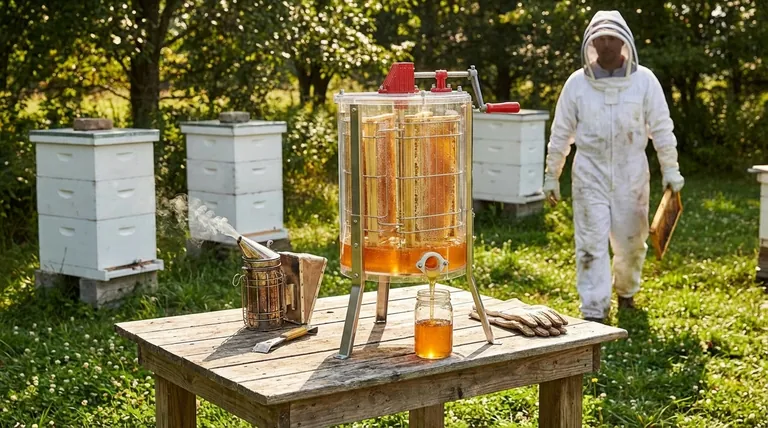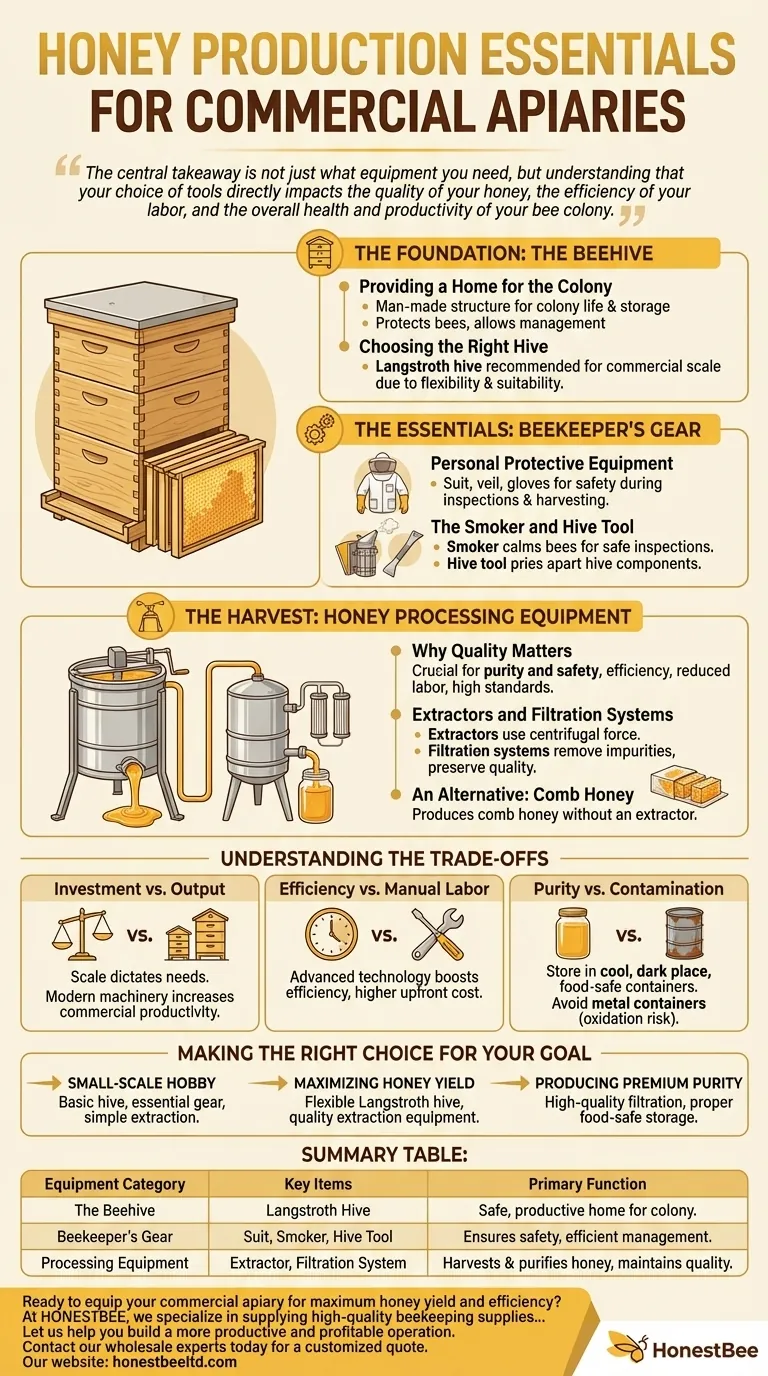At its core, honey production requires three fundamental categories of tools: a structure for the bees to live in, protective gear for the beekeeper, and the equipment necessary to harvest and process the honey. While the specific items can vary based on the scale of your operation, these three areas form the foundation of any beekeeping endeavor.
The central takeaway is not just what equipment you need, but understanding that your choice of tools directly impacts the quality of your honey, the efficiency of your labor, and the overall health and productivity of your bee colony.

The Foundation: The Beehive
A successful honey operation begins with providing a safe and effective home for the honeybee colony. The hive is the most critical piece of infrastructure.
### Providing a Home for the Colony
The beehive is the man-made structure where the honeybee colony lives, raises its young, and stores honey. A well-designed hive protects the bees from the elements and allows the beekeeper to manage the colony with minimal disturbance.
### Choosing the Right Hive
Over the years, various hive designs have been developed. For beekeepers who want to maximize honey production, the Langstroth hive is a widely recognized and excellent choice due to its flexibility and suitability for commercial-scale operations.
The Essentials: Beekeeper's Gear
Working with bees requires specific tools to ensure both the beekeeper's safety and the colony's well-being. These are non-negotiable items for any beekeeper.
### Personal Protective Equipment
A beekeeping suit, including a veil, gloves, and proper footwear, is essential to protect you from stings while inspecting the hive or harvesting honey.
### The Smoker and Hive Tool
The smoker is used to puff cool smoke into the hive, which helps calm the bees, making inspections safer and less stressful for the colony. The hive tool is a versatile crowbar-like tool used to pry apart hive components that bees have sealed with propolis (bee glue).
The Harvest: Honey Processing Equipment
Once the bees have produced honey, you need the right equipment to extract, process, and store it properly. This is where quality directly translates to your final product.
### Why Quality Equipment Matters
High-quality processing equipment is crucial for maintaining honey's purity and safety. It ensures efficiency, reduces manual labor, and upholds high product standards.
### Extractors and Filtration Systems
Modern tools like extractors use centrifugal force to remove honey from the comb without destroying it. Filtration systems then remove impurities like wax particles while preserving the honey's natural qualities.
### An Alternative: Comb Honey
Some beekeepers produce comb honey, which does not require an extractor. This method involves using special "comb honey supers" and cutting the entire comb into sections for packaging.
Understanding the Trade-offs
The equipment you choose depends on your goals and available investment. Understanding the trade-offs is key to making the right decision.
### Investment vs. Output
The scale of your operation dictates your needs. A small hobbyist can start with basic equipment, while a commercial apiary requires an investment in modern machinery to increase productivity and ensure consistency.
### Efficiency vs. Manual Labor
Advanced technology like modern extractors reduces processing time and boosts efficiency. This allows for higher production without compromising honey quality, but comes at a higher upfront cost compared to more labor-intensive methods.
### Purity vs. Contamination
Proper storage is as critical as processing. Honey should be stored in a cool, dark place inside a tightly sealed, food-safe container. Storing honey in metal containers should be avoided, as it can lead to oxidation and spoil the product.
Making the Right Choice for Your Goal
Selecting the right equipment starts with defining your primary objective.
- If your primary focus is starting a small-scale hobby: Prioritize the basic hive components, essential personal safety gear, and a simple plan for extraction.
- If your primary focus is maximizing honey yield: Invest in a flexible hive system like the Langstroth and quality extraction equipment to boost your efficiency.
- If your primary focus is producing premium, high-purity honey: Your investment in high-quality filtration systems and proper glass or food-safe plastic storage containers is non-negotiable.
Ultimately, a thoughtful investment in the right equipment empowers you to work safely, efficiently, and produce a high-quality product.
Summary Table:
| Equipment Category | Key Items | Primary Function |
|---|---|---|
| The Beehive | Langstroth Hive | Provides a safe, productive home for the colony. |
| Beekeeper's Gear | Suit, Smoker, Hive Tool | Ensures safety and allows for efficient colony management. |
| Processing Equipment | Extractor, Filtration System | Harvests and purifies honey while maintaining quality. |
Ready to equip your commercial apiary for maximum honey yield and efficiency?
At HONESTBEE, we specialize in supplying high-quality beekeeping supplies and equipment to commercial apiaries and distributors. We understand that your success depends on durable, efficient tools that protect your investment and maximize your output.
Let us help you build a more productive and profitable operation. Contact our wholesale experts today to discuss your specific needs and get a customized quote.
Visual Guide

Related Products
- HONESTBEE 3-Frame Manual Acrylic Honey Extractor
- electric honey extractor honey centrifuge 3 frame honey extractor stainless steel honey frame extractor
- HONESTBEE 72 Frame Industrial Electric Honey Extractor for Beekeeping
- 6 Frame Manual Stainless Steel Honey Extractor Beekeeping Equipment
- 40 Frame Commercial Electric Honey Extractor for Beekeeping
People Also Ask
- What machines are needed in beekeeping besides basic tools? Scale Your Honey Harvest Efficiently
- How often do beekeepers collect honey? Maximize Your Hive's Sustainable Yield
- What equipment is used for honey harvest? Essential Tools for Every Beekeeper
- How to extract honey by hand? A Guide to Crush & Strain vs. Manual Extractors
- How do you manually extract honey? Choose the Best Method for Your Hive



















